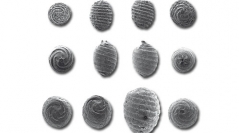

 Geodiversitas
36 (3) - Pages 385-420
Geodiversitas
36 (3) - Pages 385-420Eighteen charophyte species are documented from the Upper Eocene-Lower Oligocene transitional and terrestrial facies on the eastern Ebro Basin. The charophyte assemblage is composed of one Eurasian species, Lychnothamnus stockmansii (Grambast, 1957), fourteen species distributed throughout Europe (Harrisichara vasiformis form vasiformis-tuberculata Feist-Castel, 1977, Harrisichara lineata Grambast, 1957, Harrisichara tuberculata (Lyell, 1826), Nitellopsis (Tectochara) merianii (Al. Braun ex Unger, 1852), Lychnothamnus vectensis (Groves, 1926), L. grambastii (Feist-Castel, 1971), L. major (Grambast & Paul, 1965), Gyrogona caelata (Reid & Groves, 1921), Psilochara aff. acuta Grambast & Paul, 1965, Chara aff. antennata Grambast, 1958, C. rhenana Schwarz & Griessemer, 1994, C. microcera Grambast & Paul, 1965, Sphaerochara labellata Feist & Ringeade, 1977, Lamprothamnium sp.) and three species restricted to the Ebro Basin during the interval considered (Nodosochara jorbae Choi, 1989, Lychnothamnus longus Choi, 1989 and Chara artesica n. sp., a new species defined by very small gyrogonites and showing a reduced number of convolutions. A biogeographic analysis of the assemblage studied suggests that during Late Eocene and Early Oligocene, Europe represented a bioprovince characterised by the regular and abundant occurrence of species belonging to the lineages of Harrisichara vasiformis-tuberculata and Lychnothamnus stockmansii-major, along with Nitellopsis (Tectochara) merianii and Chara microcera in all European basins. Charophyte distribution in this bioprovince displays a north to south polarity with a reduction in the number of species. Ecological features related to the dynamics of the Ebro basin, such as the high terrigenous input in freshwater wetlands during the Upper Eocene-Oligocene, are in contrast to the sea-connected and carbonatic systems of the Paris, Hampshire and Rhine basins. This resulted in low species richness in the Ebro Basin. These biogeographic patterns have implications in the use of some European biozones, which should be of use only at a regional scale.
Charophyta, Biogeography, Eocene, Oligocene, Ebro foreland Basin, Paris Basin, Hampshire Basin, Rhine Basin, new species.